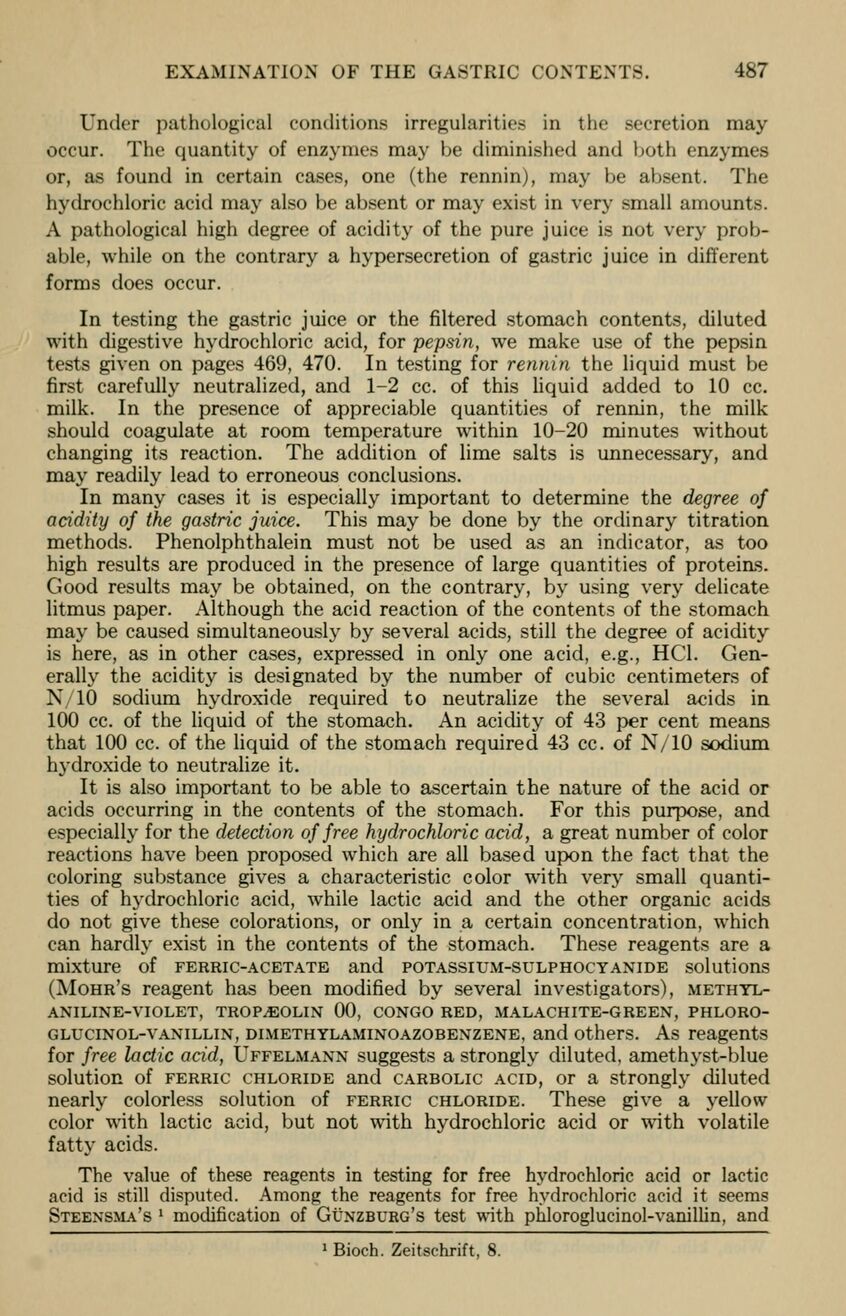
Full resolution (JPEG) - On this page / på denna sida - VIII. Digestion - II. The Glands of the Mucous Membrane of the Stomach, and the Gastric Juice

<< prev. page << föreg. sida << >> nästa sida >> next page >>
Below is the raw OCR text
from the above scanned image.
Do you see an error? Proofread the page now!
Här nedan syns maskintolkade texten från faksimilbilden ovan.
Ser du något fel? Korrekturläs sidan nu!
This page has never been proofread. / Denna sida har aldrig korrekturlästs.
EXAMINATION OF THE GASTRIC CONTENTS. 487
Under pathological conditions irregularities in the secretion may
occur. The quantity of enzymes may be diminished and both enzymes
or, as found in certain cases, one (the rennin), may be absent. The
hydrochloric acid may also be absent or may exist in very small amounts.
A pathological high degree of acidity of the pure juice is not very prob-
able, while on the contrary a hypersecretion of gastric juice in different
forms does occur.
In testing the gastric juice or the filtered stomach contents, diluted
with digestive hydrochloric acid, for pepsin, we make use of the pepsin
tests given on pages 469, 470. In testing for rennin the liquid must be
first carefully neutralized, and 1-2 cc. of this liquid added to 10 cc.
milk. In the presence of appreciable quantities of rennin, the milk
should coagulate at room temperature within 10-20 minutes without
changing its reaction. The addition of lime salts is unnecessary, and
may readily lead to erroneous conclusions.
In many cases it is especially important to determine the degree of
acidity of the gastric juice. This may be done by the ordinary titration
methods. Phenolphthalein must not be used as an indicator, as too
high results are produced in the presence of large quantities of proteins.
Good results may be obtained, on the contrary, by using very delicate
litmus paper. Although the acid reaction of the contents of the stomach
may be caused simultaneously by several acids, still the degree of acidity
is here, as in other cases, expressed in only one acid, e.g., HO. Gen-
erally the acidity is designated by the number of cubic centimeters of
N/10 sodium hydroxide required to neutralize the several aeids in
100 cc. of the liquid of the stomach. An acidity of 43 per cent means
that 100 cc. of the liquid of the stomach required 43 cc. of N/10 sodium
hydroxide to neutralize it.
It is also important to be able to ascertain the nature of the acid or
acids occurring in the contents of the stomach. For this purpose, and
especially for the detection of free hydrochloric acid, a great number of color
reactions have been proposed which are all based upon the fact that the
coloring substance gives a characteristic color with very small quanti-
ties of hydrochloric acid, while lactic acid and the other organic acids
do not give these colorations, or only in a certain concentration, which
can hardly exist in the contents of the stomach. These reagents are a
mixture of ferric-acetate and potassium-sulphocyanide solutions
(Mohr’s reagent has been modified by several investigators), methyl-
aniline-violet, TROPiEOLIN 00, CONGO RED, MALACHITE-GREEN, PHLORO-
glucinol-vanillin, dimethylaminoazobenzene, and others. As reagents
for free lactic acid, Uffelmann suggests a strongly diluted, amethyst-blue
solution of ferric chloride and carbolic acid, or a strongly diluted
nearly colorless solution of ferric chloride. These give a yellow
color with lactic acid, but not with hydrochloric acid or with volatile
fatty acids.
The value of these reagents in testing for free hydrochloric acid or lactic
acid is still disputed. Among the reagents for free hydrochloric acid it seems
Steensma’s ’ modification of Gunzburg’s test with phloroglucinol-vanilhn, and
1
Bioch. Zeitschrift, 8.
<< prev. page << föreg. sida << >> nästa sida >> next page >>